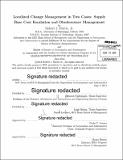Localized change management in two cases : supply base cost escalation and obsolescence management
Author(s)
Harris Robert J., Jr. (Robert Jerrell)
DownloadFull printable version (7.242Mb)
Alternative title
Localized change management in 2 cases : supply base cost escalation and obsolescence management
Supply base cost escalation and obsolescence management
Other Contributors
Leaders for Global Operations Program.
Advisor
Deborah Nightingale and Leigh Hafrey.
Terms of use
Metadata
Show full item recordAbstract
There are several models for change available to modern organizations based on decades of research. This research tends to focus on broad changes, such as enterprise transformations. This thesis presents a model developed for changes of smaller scope. These smaller changes are typically localized to a specific process or department. The Tactical Change Model is derived from existing change management literature to address these localized change efforts. The phases of the model include: Name a Goal, Investigate the Current State, Develop and "Sell" a Future State, Plan to Get From Here to There, Enact the Plan, and Spread the Knowledge. A final phase, Reflection, is used throughout the change effort. This thesis presents two cases of change at the Aerospace Systems division of United Technologies Corporation. The first case is a change in how escalation in supply costs, or headwind, is forecasted. The goal in this case is a quick, top-down method for forecasting headwind to replace a time-intensive, bottom-up method. The second case is a change in the evaluation method of obsolescence risk mitigation options. This effort is intended to improve the evaluation of these options to develop a more holistic perspective. The Tactical Change Model is used in both of these cases and evaluated using a Three Lens Analysis. The analysis generates improvements to the Tactical Change Model, including explicitly accounting for the Three Lenses throughout the model; removing the Name a Goal phase; emphasizing frequency and structure in the Reflection phase; and allowing for feedback loops.
Description
Thesis: M.B.A., Massachusetts Institute of Technology, Sloan School of Management, 2014. In conjunction with the Leaders for Global Operations Program at MIT. Thesis: S.M., Massachusetts Institute of Technology, Department of Aeronautics and Astronautics, 2014. In conjunction with the Leaders for Global Operations Program at MIT. 32 Cataloged from PDF version of thesis. Includes bibliographical references (pages 101-103).
Date issued
2014Department
Leaders for Global Operations Program at MIT; Massachusetts Institute of Technology. Department of Aeronautics and Astronautics; Sloan School of ManagementPublisher
Massachusetts Institute of Technology
Keywords
Sloan School of Management., Aeronautics and Astronautics., Leaders for Global Operations Program.